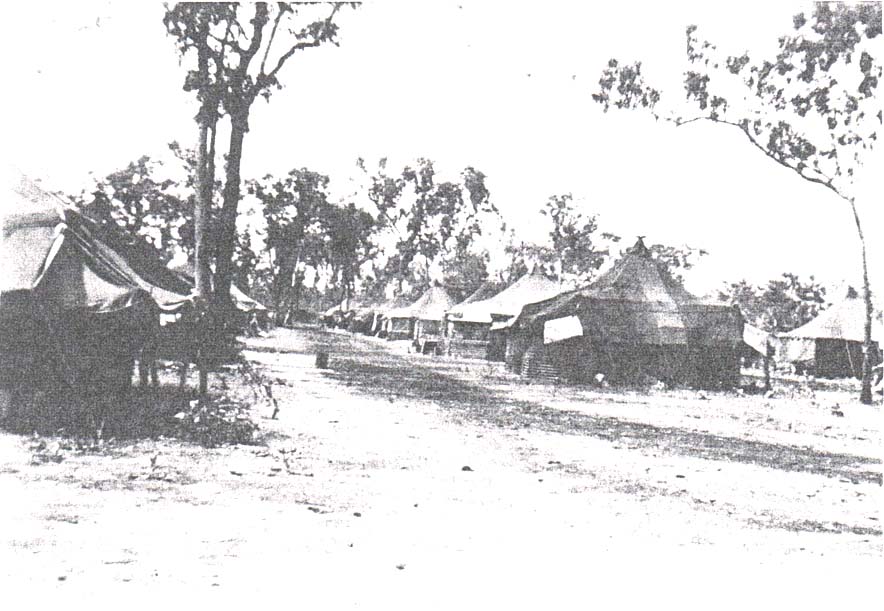380th Bomb Group Association
Newsletter 41 ~ Winter 2010
|
380th Bomb Group Association Newsletter 41 ~ Winter 2010 |
DREAM TIME - A WAR STORY
INSTALLMENT #11
by Roger W. Caputo
 |
|
An enlisted men's club was finally built by the men, most of whom had no access to lighting or a table after dark. They could read or write in some semblance of civilization. The aircrews laid their lives on the line on every mission and the airplane mechanics worked almost 24 hours per day, 7 days a week, keeping the airplanes flyable. The cooks prepared the meals three times per day and made an honest effort to make the food appetizing. The officers ate the same chow as the enlisted men, but on the other side of the fence. The social structure had to be maintained!
 |
 |
| Building the Enlisted Men's Club | Enlisted Men's Tent Area |
John K. Warren was a tall lanky boy from Mississippi. He too was a T/Sgt and the Colonel's aid-secretary. John had a Southern drawl out of this world and a perfect gentleman-in-waiting for the Colonel. We all stayed as close to John as we could, because he was on the inside as to what was going on and could keep us informed. To not be informed on the latest was unacceptable!
When things got really dull, we had to find an excuse or occasion to celebrate; translated ... get drunk! One ingenious party-lover came up with the perfect excuse that fit all occasions. It was called "Abo New Year," meaning the New Year as celebrated by the Aborigines. Of course, there was absolutely no connection at all; it was just a by-word that fit any and all occasions. Very clever!
Colonel William H. Miller, our Group Commander, was in Command from the inception of the Group. He supervised the forming of the Group; directed it through training; and led us overseas and into combat. The Colonel was from central Missouri and learned to fly in 1924 at Lambert Field in St. Louis. He was a member of the Missouri Air National Guard, a weekend warrior, and he was a Lindbergh Era flyer. He started flying for American Airlines almost from the beginning and had time in the old Curtis Condor bi-plane air transport of the late 1920s. When the War started, he was a Captain for American Airlines, flying the then-new Douglas DC-3, the airplane that put the airlines in business. I expect, being a member of the Guard, he was called up early to serve in the Army Airforce. In 1982, at the first formal Unit Reunion of the 380th Group in Dayton, he was present and I had the opportunity to talk with him. Since we were both from the St. Louis area, this served as a basis for exchanges of experiences and historical data. He was then in his early 80s and was suffering from a heart condition. Six weeks after the reunion, he died while visiting his sister in his central Missouri home area. I phoned his sister and offered her my sympathies, explaining how I knew the Colonel, as I was a total stranger to her. After the War, the Colonel helped John K. Warren get a position with American Airlines where they both worked until retirement. The Colonel retired to Southern California as did John (much later) and John looked after the aging couple.
Bomber Command of the 5th Army Airforce needed experienced help and Colonel Miller was relieved of his Command of the 380th and transferred to Bomber Command. Soon thereafter the Colonel called upon John to join him and we were never to see them again until after the war.
The Colonel recommended that his successor be a Major Forrest L. Brissey, then commanding one of the Squadrons. Forrest was promoted to Lt. Colonel and assumed command. He was a good choice. He did not have the aviation background of Miller (few did), but he was a gentleman; scholar; even tempered; responsible; and capable of exercising command responsibilities. Col. Brissey could not have been much older than 30, if that, whereas Col. Miller was probably in his early 40s. We younger people could identify with Brissey easier than Miller and as a result the atmosphere grew a bit more relaxed, but we respected Brissey and he was the Boss. Another factor came into play and it could be characterized as Civilian vs. Military. Although Miller was first a civilian, he was also a soldier because of his National Guard background. Brissey had no such military background and that in turn affected his approach to command. We were all just a bunch of civilians, working to military rules, trying to get a nasty job done as soon as possible and go home. Brissey, like many of us, had a sense of the lighter side of life and liked to do things just for fun. Somehow there was a British primary trainer available; it was the Classic Tiger Moth, used by all the British Empire as the standard trainer. It was a two-place open cockpit bi-plane of some 90 hp and a fun plane to fly. A few of them still exist among those who collect antiques. For reasons unknown, Brissey had to try his hand with the Tiger Moth and something went wrong; it crashed and he suffered a broken leg. It was a very embarrassing circumstance for Brissey and it was all very quietly sorta hushed up. I can remember thinking, "I'm a pilot and the Tiger Moth would have been just right for me and here goes a Colonel busting it up!"
 |
De Havilland Tiger Moth
http://www.sydneytigermoth.com.au/history.htm
|
 |
|
| http://www.nationalmuseum.af.mil/factsheets/factsheet.asp?fsID=354&page=3 | |
More to come!
Return to Newsletter #41 Topics page
Last updated: 22 May 2014